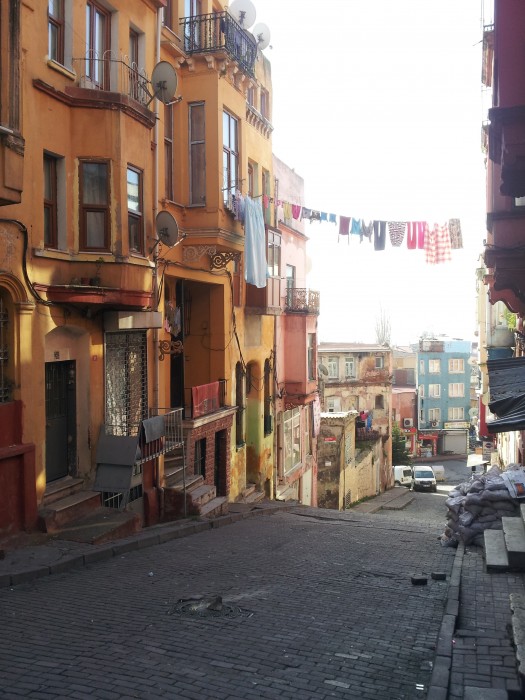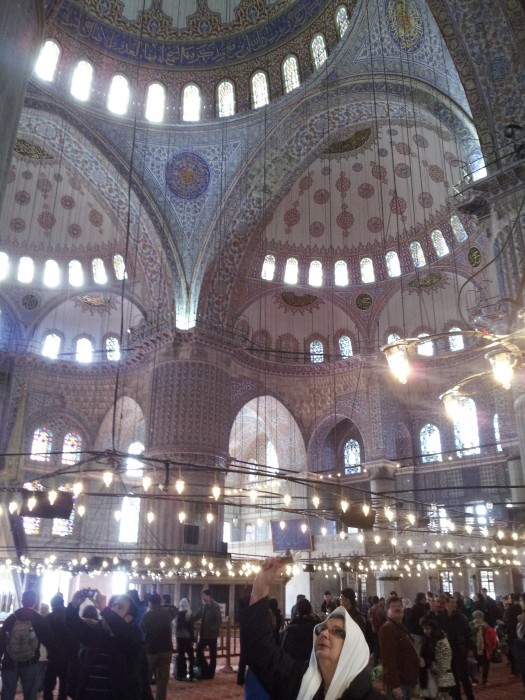It’s uplifting to visit a city that has a rich and glorious past but also an exciting future. So many cities attract tourists to their historic sites and buildings, who leave with a slightly melancholy sense that the best has gone and these cities have slipped outside the stream of history. But Istanbul is one of the few that can look both back and forwards. Turkey is emerging again as a leading and powerful country in a region fraught with tensions and inequalities.
Istanbul has been the home of the Roman Empire, under Constantine, and its successor the Byzantine Empire and then the Ottoman Empire. Geography is, to some extent, destiny. It is the junction point between Europe and Asia and controls the sea access to Russia. The Ottoman Empire included much of south eastern Europe, the whole of the Middle East and the rest of the former Islamic caliphate which extended across north Africa. It was one of the largest and longest lived empires in history which kept the Sultans in a very fine manner.

With the rise of the European powers on the back of superior technology and economic strength, the Ottoman Empire gradually declined. The key fact of Turkey’s existence then became its antagonism with Russia. Since Istanbul controlled the only warm water access to Russia’s ports, it was a constant threat. This remained the case right up until the end of the Cold War. Turkey became a member of NATO and a key US ally because it was essential for the West to make sure it didn’t get absorbed into the Soviet empire.
With the Russian threat largely gone, Turkey began to move away from the US and broke decisively after refusing to allow American planes to overfly Turkey during the invasion of Iraq ten years ago. Turkey correctly saw that the war would strengthen its long standing regional rival, Iran. (And the main beneficiaries of the end of the Saddam Hussein tyranny were the Kurds who have an autonomous near-state in north eastern Iraq, right on the Turkish border. The relationship between Turks and Kurds is, to say the least, somewhat problematic). Still in NATO but increasingly independent, Turkey is now set to re-emerge as a “great power” according to Stratfor’s George Friedman, whose fascinating analysis of Turkey’s geopolitical position is here.
Aside from its regional importance, Turkey matters as one of two countries with Islamic majorities which have a democratic, secular government and a thriving economy (the other is Indonesia). Most Islamic countries are poor and lack effective democracy, though as argued in Alan Beattie’s excellent book False Economy it is geography and history that makes this so, not Islam. I call Turkey Islamic in the sense that 99.8% of its population are Moslems, according to the CIA Factbook, (which also helpfully tells us that Turkey is slightly larger than Texas). Whether that means they are all actively so, I don’t know. The CIA reports the UK as being 72% Christian but that hugely overstates the role of Christianity in the everyday life of most British people.
Turkey’s historic decision to opt for modernisation and a secular, republican government in the 1920s, after the defeat of what was left of the Ottoman Empire in the First World War, created a fascinating experiment, one which now shows signs of success, though there are some Turks who worry that the “secular” part is not secure. They also worry that the regime is becoming too autocratic, as evidenced by the fact that there are some 95 journalists imprisoned in Turkey. (A more pessimistic view of Turkey’s political and economic future is argued by the authors of Why Nations Fail here, who see modern Turkey as still influenced and constrained by its roots in highly authoritarian Ottoman institutions.)
Impressions of Istanbul
Three things struck me on this, my first trip to Istanbul. First, the place is teeming with people and more vibrant than anywhere I’ve seen except perhaps Hong Kong. Turkey’s median age is 29, though that is doubtless lowered by the higher birth rate rural areas. Even so, this is a young and energetic place.
Second, it is astonishing commercial. There are shops everywhere and even outside the tourist zones there seems to be a highly entrepreneurial atmosphere. In the areas where tourists are more likely to go there are more luggage shops than I could imagine would ever be profitable. (Who buys all of these suitcases?) It’s not just foreign demand though. Turkey is going through a rise in private consumption fueled by a fall in the savings rate that has the IMF slightly concerned, though it mainly reflects the confidence of the rising middle class in their continued future income growth.
And third, aside from the ubiquitous mosques it has a very European feel. The overwhelming majority of people dress in a western way and there is little, aside from the minarets, to tell you that this is an Islamic country. There is a wonderful range of architecture, but most of it, other than the most famous historic buildings, looks European in style.

Like most tourists I spent time admiring those historic buildings. The Hagia Sophia, once the centre of Orthodox Christianity, then a mosque and now a museum, and the Blue Mosque are strikingly impressive, both inside and out. The Blue Mosque is one of the most beautiful buildings I’ve ever seen, with a peaceful grandeur that rivals (but doesn’t quite match, in my personal opinion) the Taj Mahal. One is a monument to spiritual love, the other to romantic love so perhaps romantic love is the more powerful.

Unlike most tourists I visited the four leading commercial banks and the Central Bank (in Ankara). Turkey’s fast growing financial system is well capitalised, soundly regulated and gets high praise from the IMF. (In this respect Turkey is not at all European). There is plenty of optimism around but some caution too, a legacy of the financial crisis that Turkey endured in 2001. Having made wrenching changes to put the financial system on a sound basis, Turkey came through 2007-09 in pretty good shape. I was endlessly reminded that there is a current account balance of payments problem. As the Blue Guide is of limited value here, I turned instead to the IMF Article IV Mission Report of December 2012.
Decoding the IMF’s rather grudging prose, the report is pretty positive, giving credit to the government for managing a slowdown from unsustainably high growth and reducing the current account deficit at a steady rate. As the public sector has improved its financial position, that of the private sector has worsened, but some of this is precisely because private individuals are more confident in public sector finances (“Ricardian equivalence” in macroeconomic jargon). The IMF urges higher private sector savings, which will require much more progress on institutional savings and pensions. Meanwhile newly prosperous Turks are taking out auto loans in large quantities, which is of course what prosperity is all about.

Turkey has a trend GDP growth rate of about 4%, at least double that of the EU (partly owing to population growth). Exports go not only to the EU but the MENA (Middle East and North Africa) region. Fears in the past that the Chinese manufacturing monster would crush traditional industry in Turkey have been reduced by the rising costs of labour in coastal China. Mexico, also expected to suffer from Chinese competition, is now thriving too. Location also matters for both these countries – being close to the two giant markets of the US and Europe is worth a small cost premium to Guangdong.
A Cambridge alumna in Istanbul is setting up a new platform for crowdfunding (on which I hope to write more in future). So is Istanbul as entrepreneurial as it seems? Views, as they say, differ on this. It takes just six days to set up a new business in Turkey, the same as the US and less than in the UK (13) and far better than Brazil (119). (Suriname is the world laggard here, where it takes 694 days – presumably nobody bothers). But Turkey is ranked 71 as a place to do business, (the US is 4th, the UK 7th and Singapore is 1st) *. I heard of bureaucratic restrictions and lengthy delays in getting regulatory approvals. Unsurprisingly there is a large informal economy which pays no tax.
Conclusion
On my first day in Istanbul I was told (by a man of course) that there are three things that are unreliable in Istanbul – the weather, the traffic and the women. I can confirm two of these from personal experience but wasn’t there long enough to form an opinion about the third. (I wonder what the women of Istanbul say about the men?) It’s hard not to like a country where the inflight magazine of the national airline includes a feature on Birmingham (England) as a tourist destination, though having visited the Turkish capital I can see how the people of Ankara might feel at home with the West Midlands’ tower blocks. I hope to visit Turkey again before long, not least because I was given such enthusiastic and generous help by all of the alumni I met, to whom I extend my thanks,

* Source: http://data.worldbank.org/indicator/IC.REG.DURS


Leave a Reply